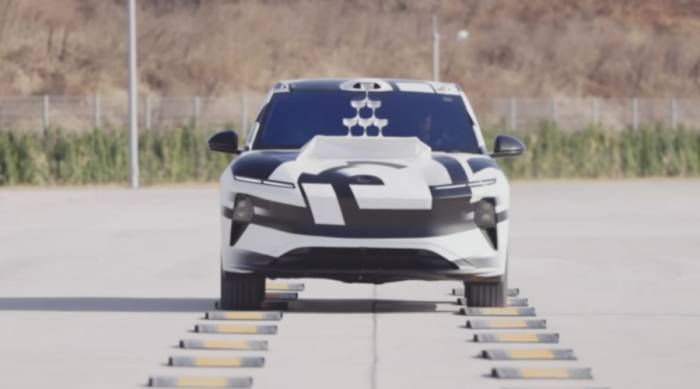Can cars skip ropes? Which functions of electric car chassis are beyond your ima
A "dancing" Maybach GLS, in sync with music that's rich in rhythm. A strong "old money scent" will waft through the screen. If the driver's seat is occupied by a buddy wearing a gold chain, the vibe is even more authentic.
In reality, it's Mercedes-Benz's off-road enhanced mode's assistance feature for getting unstuck, not a show-off trick to grab attention. It seems that it was with Maybach that people realized: a vehicle's chassis can be so magical.
To make a full-size SUV "dance," the key is the electrification of the chassis, achieved by rapid changes in vehicle height to quickly shift the center of gravity, facilitating escape in extreme road conditions. However, for a fuel vehicle, even one with a 48V mild hybrid system, the electrical energy that can be allocated to the chassis is ultimately very limited.
Fortunately, the proliferation of electric vehicles has "unsealed" the electrical energy on the chassis. Thus, we see the ET9 carrying a champagne flute over a speed bump; the shock absorbers of the Upright U7 generating electricity... Of course, there are even wilder examples, such as the whole vehicle jump rope of Haobo, which was showcased at the Haobo Smart Digital Chassis launch event.
Electrified chassis, magical powers soaring to the sky?
In fact, shock absorbers and springs, as crucial components of the chassis, are responsible for the Z-axis movement, which indeed soars to the sky. As for electrified suspension, in the current context of intense competition among domestic brands, it is by no means an unattainable feature, such as CDC (Continuous Damping Control).
Advertisement
Even in domestic models costing around a hundred thousand, you can find CDC configurations. For instance, the Exeed Star Way has CDC on its mid-tier model priced at 174,800 yuan.
The principle involves adjusting the opening and closing degree of the solenoid valve to control the flow of fluid within the shock absorber, thereby controlling the damping device. This allows the chassis feedback to be softer or harder, catering to different drivers' styles.
Another type already applied in passenger cars is the magnetorheological damper (MR Dampers) used in American luxury vehicles, which changes damping by relying on the viscosity of the fluid. For example, if you replace the saline solution in the shock absorber with syrup, the resistance you feel when pushing the syringe would naturally be different.
Of course, what often accompanies variable damping shock absorbers is air springs, complemented by double wishbone suspension, thus forming the suspension combination of today's luxury cars. And the air springs that can automatically inflate and deflate are also a result of the electrification of the chassis.Under the high-voltage platforms of electric vehicles ranging from 400V to 800V, the "capability" of shock absorbers and air springs is also amplified. At the Haobo Smart Digital Chassis launch event, it was demonstrated that its chassis system can reach a peak power of 20kW, with a lifting speed that can even exceed 250mm/s. This also directly provides the foundation for Haobo to complete the whole vehicle's jumping rope action.
Even more, the high peak power of Haobo's chassis system allows the vehicle's jumping height to reach 150mm.
More perception hardware, chassis from passive to active
The internal competition among domestic brands on the path of intelligent driving has made the development speed of perception and decision hardware exceed the imagination of chassis engineers.
In fact, hardware such as LiDAR and millimeter-wave radar, in addition to serving high-speed and urban pilot assistance, can also provide pre-aiming for the active adjustment of the chassis. For example, when passing over a large speed bump, it can perform operations such as raising the suspension and reducing the shock absorber damping. This technology has already been realized in NIO, officially called AI Smart Chassis.
After the perception hardware provides sufficiently credible information, the decision-making level has gradually matured chips as the foundation. Nowadays, the computing power of hundreds or even thousands of TOPS has enough redundancy to provide instructions on how the active chassis should move. Of course, this also requires execution components with fast response. Therefore, adding high voltage to the execution components is also essential.
Can ordinary people afford advanced chassis?
Perception, decision-making, and execution, the three sets of components of the chassis system seem to be busier than the drive motor when dealing with different road conditions, which inevitably leads to the high cost of the active suspension system. Taking the NIO ET7 equipped with AI Smart Chassis as an example, the price of the entry-level model is as high as 428,000. Even if you choose the rental power plan, the 75kWh version also costs 358,000.

However, the cost reduction after technology is downsized exceeds our imagination. For example, the active rear spoiler of the Audi A7, which was once dreamed of by countless young people, has now appeared on the MG7 at the level of 100,000.
On the other hand, the more precise control of vehicle dynamics after the chassis is electrified can already benefit many models.For instance, the Hawk Claw system and the Flying Magic Carpet of Haobo can increase the suspension damping of the front axle during braking, thereby alleviating the occurrence of brake dive; on the other hand, when the vehicle is cornering, it can also increase the damping of the outer wheels, thereby reducing the roll angle. Similarly, more precise control of the drive motor torque can enhance the vehicle's cornering tracking ability, which can significantly improve safety on low-adhesion surfaces such as rainy or snowy days.
Taking the Hawk Claw system of Haobo as an example, the vehicle's deviation on icy and snowy roads can be reduced by 1.75 meters.
Thus, the results of electrifying the chassis seem to have approached or even reached the level of Porsche's Torque Vectoring Plus (PTV Plus) system from the perspective of the user's driving experience. Yes, good designs always have a kind of telepathy.

Comment